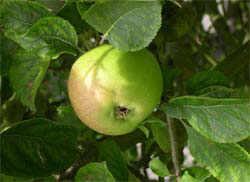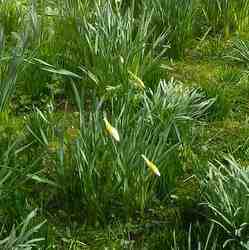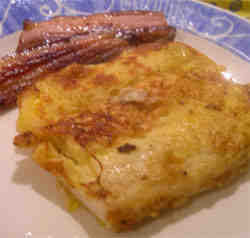Old Fashioned Apple Jelly Recipe
Posted by Fiona Nevile in Jam Jelly and Preserves | 106 comments
A green cooking apple
We always use cooking apples for apple jelly so that it is not too sweet and much more adaptable. For years I only thought of jelly as an accompaniment to meat. The jars opened and enjoyed but usually lost in the depths of the fridge. I cringe now at the thought of the great jellies that must have been wasted on us.
Over the past couple of years we have begun to discover the breadth of the jelly repertoire. Initially, we worked hard trying to make jelly with a good flavour, rather than the ultra sweet stuff that I remember as a child. I asked all my clients for tips. Armed with this unique knowledge, (most of them are good, inventive cooks) and a lot of experimentation we have finally made a small range of jellies that we think are good. This delicate apple jelly is one of the stars.
As we had all these pots of jelly crowding out the larder we were forced to become adventurous. We found that a decent dollop of a stronger jelly in a stew lifted the flavours. We ate it with cheese. We used it in casseroles, as a sauce base for pork and chicken and stirred it into hearty winter soup. We even tried in stir fries (great with a chicken or duck.
We found that dark meat and game cry out for a slightly stronger jelly, such as our damson or wild plum. We also make a punchy sloe and Bramley jelly which adds an extra fillip to a pheasant or venison dish. If we run out of the more raunchy jelly, Danny adds a slug of sloe gin, although I prefer the sharper fruity effect of damson gin. A dash of sloe or damson gin is super in stews, sauces and gravy. You can’t taste the alcohol, just a deep, mellow flavour.
Old Fashioned Apple Jelly Recipe
Ingredients:
- 4 pounds/1.8 kilos of cooking apples (windfalls are fine for this recipe)
- 2 UK pints/1140ml/5 cups of water
- Grated rind and juice of one large lemon
- White granulated sugar (the amount depends on the volume of juice extracted from the simmered, drained fruit. 1 pint/500ml/2 1/2 cups of juice to 1 pound/454gms of sugar. I always make sure that I have a 2 kilo bag of sugar in the larder, just in case I fancy making jelly)
Method:
- Wash the apples, cut out bad bits and chop roughly. There is no need to peel and core the apples.
- Carefully grate the lemon zest from the lemon (we use a zester but a fine grater will do. Try to avoid including the pith as this would make the jelly bitter).
- Place fruit and lemon zest in a large deep heavy bottomed saucepan, or preserving pan. Add the water and bring gently Bring gently to the boil and simmer very gently until all the fruit is soft and mushy (roughly 25 minutes, depending upon how ripe the fruit is).
- Pour the cooked fruit through sterilised muslin. (How do I sterilise muslin? See tips and tricks below). The muslin is often referred to as a “jelly bag”. We use tall buckets to catch the drips from the jelly bags. Rather than hang the bags (conventional method-between two stools) I find it easier to line a large plastic sieve with the muslin. This clips neatly onto the top of a clean bucket. The sieve is covered with a clean tea cloth to protect against flies, as the jelly bag generally drips overnight.
- Measure the apple juice the next day and pour it into a deep heavy bottomed saucepan. Add 454g/1 pound of white granulated sugar for each 570ml/1 pint/2 1/2 cups of juice.
- Add the juice of the lemon.
- Heat the juice and sugar gently, stirring from time to time. Make sure that that all the sugar has dissolved before bringing the liquid slowly to the boil. Continue to boil for about five minutes before testing for a set. (What is testing for a set? See tips and tricks below).
- Toss in a nugget of butter towards the end to reduce the frothing that often occurs.
- When jelly has reached setting point pour into warm sterilised jars using a funnel and ladle. (How do I sterilise jars? See tips and tricks below).
- Cover immediately with plastic lined screw top lids or cellophane tops secured with a rubber band.
Label when cold and store in a cool, dark place. Away from damp. (My jelly is too liquid. See Tricks and tips below)
Tips and tricks:
- What is a jelly bag?
A jelly bag is traditionally a piece of muslin but it can be cheesecloth, an old thin tea cloth or even a pillowcase. The piece needs to be about 18″ square. When your fruit is cooked and ready to be put in the jelly bag, lay your cloth over a large bowl. Pour the fruit into the centre of the cloth and tie the four corners together so that they can be slung on a stick to drip over the bowl. Traditionally a stool is turned upside down, the stick is rested on the wood between the legs and the jelly bag hangs over the bowl. We experimented and now line a sieve with muslin, place it over a bucket and cover the lot with clean tea cloths (against the flies). - How do I sterilise muslin/the jelly bag?
Iron the clean jelly bag with a hot iron. This also works with tea cloths. - What is Jam “set” or “setting point”?
Getting the right set can be tricky. I have tried using a jam thermometer but find it easier to use the following method. Before you start to make the jam, put a couple of plates in the fridge so that the warm jam can be drizzled onto a cold plate (when we make jam we often forget to return the plate to the fridge between tests, using two plates means that you have a spare cold plate). Return the plate to the fridge to cool for approx two minutes. It has set when you run your finger through it and leave a crinkly track mark. If after two minutes the cooled jam is too liquid, continue to boil the jam, testing it every few minutes until you have the right set. The jam is far more delicious if it is slightly runny. - How do I sterilise jam jars?
We collect jars all year round for our jelly, chutney and jam making sessions. I try to soak off labels and store the clean jars and metal plastic coated screw-top lids in an accessible place. The sterilising method that we used is simple. Just before making the jam, I quickly wash and rinse the jars and place them upside down in a cold oven. Set the temperature to 160c (140c fan-assisted). When the oven has reached the right temperature I turn off the heat. The jars will stay warm for quite a while. I only use plastic lined lids for preserves as the all-metal lids can go rusty. I boil these for five minutes in water to sterilise them. If I use Le Parfait jars, I do the same with the rubber rings.
Leave a reply







I just made my first jelly. I feel like I cheated but hope I didn’t.
I used one of those new steam juicers that lakeland sell. It means no hanging jelly bags or waiting over night.
I also used jam sugar with the pectin added. you boil it for just 4 mins. They haven’t set yet and I’m fretting they won’t but apparently this sugar never fails….
Thanks for the basic recipe and confidence to give it a o.
Thanks for advice. Lakeland sell lids and Ikea sell preserving jars. Forgot to ask how long would chutney and jelly keep – if I make it now will it keep till Christmas? Thanks
Hello SandraB
You need an proper lid for chutney, might be worth ringing Lakeland as I think that they may sell lids. Otherwise use a Le Parfait jar.
It’s always worth saving lids with jars as most sizes are universal.
Our old apple tree has this year decided to produce bags and bags of fruit. I hope to make chutney and jelly but only have glass jars but no lids. Can I use same polythene lids I use for jam? Any suggestions
Our very old apple tree has this year decided to produce bags and bags of apples.I intend to use a lot of them for chutneys and jellies etc but only have glass jars without any lids to store them in. Used to use polythene covers – can you still get them? Do they work for chutney?
I use windfalls mainly worcester eating apples for my jelly’s.I made one batch that would not set, even though a bottle of certo and lemon juice was added. Can it be he ripeness of the apples that makes the difference?. I would appreciate any good advice.
My apples seem to be ready all at once! As a recent retiree with grudging access to the kitchen – and the oil-fired range – I want to process the apples into jellies in two phases: reduce all of the apples to liquid and then, on separate occasions, produce the various jellies from ‘stock’. We have to use the range sensibly to conserve oil and heat. Have you ever tried freezing the apple liquid? How else might I store the liquid for a couple of weeks? (Hmm. Like the Calva idea. I have heard of whiskey in apple jelly, but Calva seems more appropriate somehow).
Hi Kren
Calvados sounds good. Add incrementally to taste.
Hi Sam
how about aplle chillie jelly – we had people ringing up for more within a couple of days of being given a jar!
Hi guys,
I am absolutely loving the site. My sister an I are making some jams, gins and pickles etc for hampers for xmas. We have been given some eating apples and are looking at the apple jelly recipe but have a couple of questions – what do you think will add the most flavour to it to make it more interesting and also how long do you think it will last in the jars?
Any help would be greatfully received.
Hi there…
I want to add some Calvados Brandy to my apple jelly. Is this an o.k. spirit to use and if so, how much would you recommend?